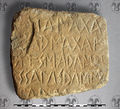TV-1.1: Difference between revisions
No edit summary |
No edit summary |
||
| Line 14: | Line 14: | ||
|condition=damaged, fragmentary | |condition=damaged, fragmentary | ||
|checklevel=1 | |checklevel=1 | ||
|problem=bitte eine fachmeinung | |problem=bitte eine fachmeinung, Sartori (Publikationsgeschichte) | ||
|disambiguation=TV-1 | |disambiguation=TV-1 | ||
}} | }} | ||
== Commentary == | == Commentary == | ||
First published by '''Sartori 1951: 14 f.''' | |||
Pictures in {{bib|Pellegrini & Prosdocimi 1967}}: 400 (photo) and {{bib|Morandi 1999}}: fig. 32 and 33 (photos) and 34 (drawing). | |||
Although the Latin inscription was already discovered by '''Sartori''', later scholars were in large part interested exclusively in the [[index::TV-1.2|allegedly Raetic inscription]] on the reverse (or obverse, depending on interpretation). The existence of a second inscription was not even mentioned by most of them, despite the possibilities opened for interpretation by a potential bilingua. It is noted and reproduced in the {{bib|Pellegrini & Prosdocimi 1967|Lingua Venetica}}, with the comment "di dubbia trascrizione" (p. 400); similarly, {{bib|LIR|Mancini}} refers to "un'iscrizione di età romana di difficile lettura" (p. 278). | |||
The first to attempt a reading and interpretation was Alessandro {{bib|Morandi 1999|Morandi}} (pp. 99 ff.) | |||
{{bibliography}} | {{bibliography}} | ||
Revision as of 19:34, 28 October 2014
| Inscription | |
|---|---|
| Transliteration: | ? |
| Original script: | ? |
|
| |
| Object: | TV-1 slab (sandstone) (Inscriptions: TV-1.1, TV-1.2) |
| Position: | |
| Script: | Latin script |
| Direction of writing: | dextroverse |
| Letter height: | 33 cm <br /> – 4 cm |
| Craftsmanship: | engraved |
| Current condition: | damaged, fragmentary |
| Date of inscription: | |
| Date derived from: | |
|
| |
| Language: | unknown |
| Meaning: | unknown |
|
| |
| Alternative sigla: | none |
Images
Commentary
First published by Sartori 1951: 14 f.
Pictures in Pellegrini & Prosdocimi 1967: 400 (photo) and Morandi 1999: fig. 32 and 33 (photos) and 34 (drawing).
Although the Latin inscription was already discovered by Sartori, later scholars were in large part interested exclusively in the allegedly Raetic inscription on the reverse (or obverse, depending on interpretation). The existence of a second inscription was not even mentioned by most of them, despite the possibilities opened for interpretation by a potential bilingua. It is noted and reproduced in the Lingua Venetica, with the comment "di dubbia trascrizione" (p. 400); similarly, Mancini refers to "un'iscrizione di età romana di difficile lettura" (p. 278).
The first to attempt a reading and interpretation was Alessandro Morandi (pp. 99 ff.)
Bibliography
| IR | Alberto Mancini, "Iscrizioni retiche", Studi Etruschi 43 (1975), 249–306. |
|---|---|
| Lejeune 1951 | Michel Lejeune, "L'Inscription Rétique de Castelcies", Studi Etruschi 21 (1951), 209–214. |
| LIR | Alberto Mancini, Le Iscrizioni Retiche [= Quaderni del dipartimento di linguistica, Università degli studi di Firenze Studi 8–9], Padova: Unipress 2009–10. (2 volumes) |

